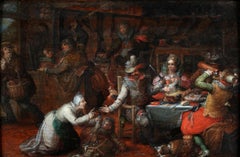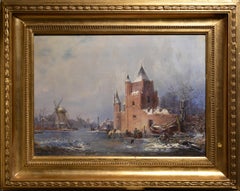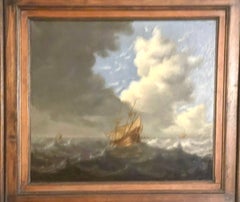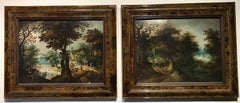David Vinckboons Art
to
1
1
1
Overall Height
to
Overall Width
to
1
1
1
1
1
1
6,952
3,302
2,514
1,213
1
1
1
Artist: David Vinckboons
The peasant's sorrow - David Vinckeboons (1576 - 1632)
By David Vinckboons
Located in Gent, BE
Oil on panel
Around 1620.
A family of well dressed townspeople indulge in food and beverages in a tavern.
In the left corner, a poor man carrying a basket is being sent away by f...
Category
17th Century Dutch School David Vinckboons Art
Materials
Oil, Panel
Related Items
Castle and Windmills at Frozen Pond Dutch Winter Landscape 19th century Oil
Located in Stockholm, SE
Painting signed lower right "M Kruseman". What sets this painting apart is the large number and complexity of details that the artist managed to include in the scene without visually overwhelming the viewer. The color palette of the landscape is very realistic and harmonious. The foreground of the picture there are people standing by a sleigh drawn by one horse, in front of a charming small castle with turrets, nearby boats frozen in the ice at the pier are visible. The background, on the left side of the scene, we see houses and three windmills standing tall against the winter sky, adding a touch of Dutch countryside charm to the composition. From the frozen surface of the water, the whimsical silhouettes of trees to the intricate details on the façade of the castle and windmills - every element of the painting is a testament to the skill and talent of the artist. Antique oil painting on canvas, signed, framed.
Size app.: 40,5 x 57.5 cm cm (roughly 15.9 x 22.6 in), frame is 60 x 75.5 cm (roughly 23.6 x 29.7 in). Very good ready to hang condition with age wear and retouches to frame (notable at close examination). Please study good resolution images for cosmetic condition. In person actual painting may appear darker or brighter than in our pictures, strictly depending on sufficient light in your environment. Weight of app. 4.7 kg is going to measure 8 kg packed for shipment.
Signature leads to the artist Fredrik Marinus Kruseman (1816 - 1882), Dutch painter who specialized in Romantic style landscapes (sold as is). Received his first drawing lessons from Jan Reekers (1790 - 1858) and attended the Vocational School in Haarlem from 1832 to 1833. That year, he began to study painting with Nicolaas Johannes Roosenboom and, in 1835, moved to the Gooi, where he took advanced studies with Jan van Ravenswaay. He also studied briefly with the landscape painter, Barend Cornelis Koekkoek.
Category
Mid-19th Century Dutch School David Vinckboons Art
Materials
Canvas, Wood, Cotton Canvas, Oil
Dutch ships on rough seas 17th Century
Located in Hillsborough, NC
Dutch School, 17th century oil painting on board, this work features a golden ship on blue seas with white crests against a stormy clouded sky. In the distance more ships can be seen, and a spot of blue sky gives the stormy clouds relief. Light shines through the white clouds casting shadows of color on the gray storm and choppy sea waters. Dramatic and masterful.
Presented in overall very good condition in what may be the original mahogany wood frame.
Excellent for an office, library, den or study, but can also be effective in a living room, dining room or bedroom.
The frame has a rich wood tone. Easy to ship and ready to hang.
Check out our Saltire Gallerie...
Category
17th Century Dutch School David Vinckboons Art
Materials
Oil, Board
FLOWERS - Dutch School -Italian Still Life Oil on Canvas Painting
By Carlo De Tommasi
Located in Napoli, IT
Flowers - Carlo De Tommasi Italia 2008 - Oil on canvas cm. 90x60
In this painting Carlo De Tommasi is inspired by the eighteenth-century works of Abrham Bosschaert Dutch painter, kno...
Category
Early 2000s Dutch School David Vinckboons Art
Materials
Oil, Canvas
Belgian painting 19th VAN STRIJ oil on wood Lanscape cattle children ruin
By Jacob van Strij
Located in PARIS, FR
Jacob VAN STRIJ (Entourage of) Dordrecht, 1756 - 1815 Oil on panel 46 x 60 cm (64.5 x 79 cm with the frame) Inscription on the back “Van der Eyden? » Very beautiful 19th century frame in gilded wood Very good condition (only a few stains)
Our painting is very close to the art of Jacob van Strij studied and may have been painted in the circle of this artist. Jacob van Strij studied at the Academy of Painting in Antwerp and with Andreas Lens. Back in Dordrecht, he became a landscape painter. Both individually and with his brother Abraham, he painted various wallpapers for clients in Dordrecht. According to Jacob van Strij biographer Johannes Immerzeel, “His passion and concern for faithfully imitating nature went so far that Van Strij, as ill as he was (for years Van Strij was plagued with gout) he asked someone to pull his sled along the ice in the biting cold in order to make sketches for his paintings, which he then executed in his workshop ”. Van Strij used these sketches for various paintings. He was inspired by 17th century old masters, in particular Albert Cuyp...
Category
Early 19th Century Dutch School David Vinckboons Art
Materials
Oil
Feeding the Baby
Located in Wiscasett, ME
Oil on canvas, signed upper left. Provenance: Sothebys Amsterdam, Private collection London, Private collection Palm Beach.
His working period was from about 1894 to 1973, successively in Rotterdam, Heeze (Heeze-Leende), Hilversum and Laren. He was educated at the Craft School for decorative painters and received evening lessons at the Rotterdam Academy under the direction of A. van Maasdijk.
He was a member of the Vereeniging Sint Lucas...
Category
Early 20th Century Dutch School David Vinckboons Art
Materials
Oil
Barend Graat (1628-1709) Diana the huntress and her dogs
Located in BELEYMAS, FR
Barend GRAAT
(Amsterdam 1628 – Amsterdam 1709)
Diana the Huntress
Oil on wood
H. 33.5 cm; L. 44 cm
Signed lower right on the stone
A discreet painter with respect to history, Barend...
Category
1650s Dutch School David Vinckboons Art
Materials
Oil, Wood Panel
H 13.19 in W 17.33 in
Study of Apples, Pears, Caterpillar, Butterflies and Mice - by Johannes BOUMAN
Located in Blackwater, GB
Study of apples, pears, caterpillar, butterflies and mice, dated 1635
Johannes BOUMAN (1601-1658)
17th century Dutch master study of pear...
Category
17th Century Dutch School David Vinckboons Art
Materials
Panel, Oil
STILL LIFE - Massimo Reggianil - Oil on Canvas Italian Painting
By Massimo Reggiani
Located in Napoli, IT
STILL LIFE - Oil on canvas painting by Massimo Reggiani, Italy 2006
The origins of still life can be found in Dutch painting. At the beginning of Dutch painting, artists included add...
Category
Early 2000s Dutch School David Vinckboons Art
Materials
Oil, Canvas
Classical Dutch Interior Still Life Painting of a Water Jug, Fruit, and Tapestry
Located in Houston, TX
Classical still life painting of a metal water jug, a collection of various fruits, and an ornate tapestry beautifully executed in the Dutch school style. Signed by the artist in the lower left corner. Currently framed in a complimentary gold and black frame with a thin green matte.
Dimensions Without Frame: H 19 in. x W 23 in.
Artist Biography:
Eduard Peter Moleveld was born in the Netherlands in 1946. He is primarily known for his realistic Dutch style still life...
Category
Mid-20th Century Dutch School David Vinckboons Art
Materials
Oil
At Grandmother’s
Located in New York, NY
signed in the lower left Artz
oil on canvas
26 x 19 ⅝ inches (66 x 50 cm.)
PROVENANCE
D. Sala & Zonen, Leiden , prior to 1936
Private Collection, Florida, circa 1968 until the present time
Much like their seventeenth century counterparts, a group of painters known as the Hague School in the 1870s came to embrace as their subject matter the native Dutch landscape and the everyday lives of its rural inhabitants, most notably the fisher folk of the coastal villages. Within ten years the Hague School artists’ works would prove so popular that incredibly a mania for all things Dutch would be felt throughout the world, and would dominate the art in Holland until well after the turn of the century. By embracing simple themes remarkable for their ordinariness, the Hague School succeeded in striking a chord with a public whose own placidity was constantly being rattled by the evolving modernity of the times. Conveyed through the employment of subtle tones, hazy skies and subjects of happenstance their mix of nostalgia and realism enchanted viewers. The Hague became the center of the movement because it was semi-rural surrounded by meadows, polders, waterways, dunes and woods, and nearby Scheveningen provided a wealth of material for artists seeking to paint the shore and its fishing community.
Jozef Isräels was considered the dean of the Hague School and David Adolphe Constant Artz his most important follower. Artz began his training in 1855 at the Amsterdam Academie under Louis Roijer and Johannes Egenberger, and would remain in Amsterdam until 1864. During this period, he would be influenced by August Allebé but more importantly a lifelong friendship with Jozef Israëls formed. In 1859 they traveled together to Zandvoort. He would also be the first of the Hague School artists to follow Isräels’ lead of working on the beach at Scheveningen. In 1859 Artz publically exhibited for the first time, taking part in the Tentoonstelling von Levende Meesters (Exhibition of Living Masters). In 1864 he left Amsterdam to live in Zweeloo, Drenthe for a year. From 1866 until 1874 he shared a studio with Jacob Maris and Frederick Hendrik Kaemmerer. He was one of the first of the Hague School artists to work in Paris (Jacob Maris having preceded him by one year) enabled by his patron and benefactor Johannes Kneppelhout. Artz created quite a commotion upon his arrival by including in his baggage a large collection of Scheveningen peasant costumes. As previously in Holland, Artz during his sojourn in Paris continued to paint beach scenes and interior views that featured the fishing communities of the North Sea. During this period Artz became interested in Japanese prints which had recently become available in Paris, and painted a few genre scenes of interiors with Japanese décor and subjects. While based in Paris he also traveled to Scotland from May-June 1869, Germany in November of that year, England in 1870 and Italy in January, 1872. By 1874 he returned to the Netherlands to live permanently in The Hague.
Artz in his own time was held in high esteem by the public as well as his fellow artists. He was awarded gold medals at exhibitions in Munich and Vienna, as well as a Diploma and Medal of Honor in Dresden. In 1879 he was made Knight of the Oaken Crown of Luxembourg and in 1889 also became a Knight of the Order of St. Michael of Bavaria. In 1880 he received an Honorable Mention at the Salon in Paris and won a gold medal in 1883 at the International and Colonial Exhibition, Amsterdam. In Paris he was a member of the Société Nationale des Beaux Arts and a Chevalier of the Legion of Honor by 1889. He also served as Vice President of the International Jury of Award at the 1889 Exposition Universelle, Paris. In 1893 four works by Artz were chosen to be included in the World’s Columbian Exposition, Chicago. An American reviewer wrote of this show “The works of giants like Rembrandt, Van der Neer, Ruysdael, Holbein and Franz Hals are almost equaled now by masters like Israels, Mesdag, Bosboom, Maris, Mauve and Artz”. Artz’s entries A Girl Knitting, The Pet Lamb, Idle Hours on the Dunes and Girl Sleeping on the Dunes were listed under the category of “Immortal Works”. His works formed part of museum collections of Amsterdam (Rijksmuseum and Municipal Museum); Cambridge, England; Chicago; Dordrecht; Glasgow; Haarlem; The Hague (Gemeentemuseum and Mesdag Museum); Leewarden; Montreal; New York (Brooklyn and the Metropolitan Museum); Oxford; Rotterdam; St. Louis; Tulsa and Zandvoort.
Much enamored with the picturesque dwellings of the rural population, a favorite subject of the Hague School was the depiction of a family group gathered around a table sharing a simple meal. Ronald de Leeuw in his introduction for The Hague School Book remarked that the group “derived poetry from a view of the kitchen”. Artz excelled at this type of interior scene in which every detail has been carefully recorded in emulation of his seventeenth century predecessors. Vincent van Gogh, an admirer of the Hague School in general and Artz in particular, wrote to his brother Theo in a letter dated Etten, Friday, August 26, 1881 about an exhibition in The Hague he had just visited in which he described a drawing by Artz of an “old man and woman eating porridge, very important, very good and serious.”
There is a large version of At Grandmother’s (131.5 x 91.5 cm.) in the Rijksmuseum, Amsterdam. It was painted in 1883 and shown in an exhibition in The Hague in 1884 where it was purchased by the museum. This undoubtedly must have sparked interest in the composition and created a demand for the image to be replicated as several versions of the composition in varying sizes are recorded, and Artz was known for executing repetitions of his own works. Regarded as one of the highlights of the collection in the Philbrook Museum of Art in Tulsa, Oklahoma is another version by Artz of At Grandmother’s. The iconic nature of the image must have appealed to contemporaries as the perfect summation of the mix of idealism and realism that characterized these artists and their times.
In a cottage under a wooden beamed ceiling a grandmother with her two granddaughters clothed in the traditional garb of Katwijk (where the artist spent his summers and maintained a cottage in the dunes) sit on wooden chairs around a gate-leg table in a kitchen sharing a simple meal of bread and an apple. The grandmother carefully slices a piece of bread while the younger girl looks on expectantly. Her sister sips milk from a small delftware bowl watching...
Category
Mid-19th Century Dutch School David Vinckboons Art
Materials
Oil
Sailing Vessels in Calm Seas Offshore - Sailboat Sail Boat 19th cent oil/panel
Located in Rancho Santa Fe, CA
George Willem Opdenhoff
Fulda, Prussia 1807 – 1873 The Hague
"Sailing Vessels in Calm Seas Offshore"
Oil on panel
9 7/8 x 12 7/8 inches (25 x 33 cm.)
signed lower left: G W Opdenhof...
Category
Mid-19th Century Dutch School David Vinckboons Art
Materials
Oil, Panel
The Grape Seller by Jacob Ochtervelt (Workshop), Oil on Canvas, Period Frame
Located in Stockholm, SE
Jacob Ochtervelt (Workshop)
The Grape Seller
There are two known versions of this subject.
This is a reduced variant of Ochtervelt's signed and dat...
Category
1660s Dutch School David Vinckboons Art
Materials
Canvas, Oil
Free Shipping
H 43.12 in W 35.04 in
Previously Available Items
Hunters Shooting Geese, old masters Dutch painting pair attrib. to Vinckboons
By David Vinckboons
Located in Santa Fe, NM
Hunters Shooting Geese
Artist/maker: Attributed to David Vinckboons Origin/country: Flemish, 1576-1632
Medium: Oil on wood panel, a pair Style/form: Landscapes
Dimensions: Height: 19...
Category
17th Century David Vinckboons Art
Materials
Oil
David Vinckboons art for sale on 1stDibs.
Find a wide variety of authentic David Vinckboons art available for sale on 1stDibs. You can also browse by medium to find art by David Vinckboons in oil paint, paint, panel and more. Not every interior allows for large David Vinckboons art, so small editions measuring 12 inches across are available. Customers who are interested in this artist might also find the work of Carlo De Tommasi, Leon Herbo, and Salvatore Marinelli. David Vinckboons art prices can differ depending upon medium, time period and other attributes. On 1stDibs, the price for these items starts at $90,000 and tops out at $90,000, while the average work can sell for $90,000.



